Dancing With The Stars
Aspiring young dancers follow their dreams with the Boston Ballet
Lisa Leslie Henderson writer
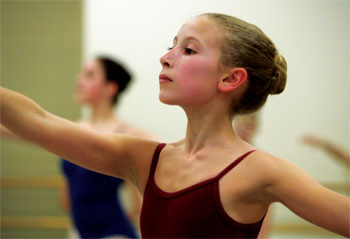 Like many aspiring young dancers, fourteen-year-old Lauren Baltrus has cherished the dream of dancing in The Nutcracker since her mother sewed the straps on her first ballet slippers. The chance to perform under the lights as a playful Polichinelle mysteriously appearing from underneath Mother Ginger’s skirt, or a toy soldier battling against the Mouse King, or the innocent young Clara who wins the heart of the prince, provides the energy and motivation for hours of strenuous training, lengthy rehearsals, and late-night schoolwork, not to mention the expense of numerous pairs of dance slippers. Consider this statistic: if all the pointe shoes used in one season of The Nutcracker were lined up from heel to toe, they would circle the Boston Common.
Like many aspiring young dancers, fourteen-year-old Lauren Baltrus has cherished the dream of dancing in The Nutcracker since her mother sewed the straps on her first ballet slippers. The chance to perform under the lights as a playful Polichinelle mysteriously appearing from underneath Mother Ginger’s skirt, or a toy soldier battling against the Mouse King, or the innocent young Clara who wins the heart of the prince, provides the energy and motivation for hours of strenuous training, lengthy rehearsals, and late-night schoolwork, not to mention the expense of numerous pairs of dance slippers. Consider this statistic: if all the pointe shoes used in one season of The Nutcracker were lined up from heel to toe, they would circle the Boston Common.
Lauren’s hard work has paid off. The Wellesley native has already performed several roles in the Boston Ballet’s rendition of The Nutcracker. “I was eight years old in my first Nutcracker and had the role of Marzipan Doll, which meant I stood on the stage for about one minute during a battle scene in a beautiful costume and didn’t dance, but it was fun to be part of it all,” Lauren recalls. The following years, Lauren went on to dance the roles of the Baby Mouse and a Polichinelle, and eventually, during her fifth and sixth years, she landed her dream role as Clara. “Playing Clara is simply magical,” Lauren says.
Lauren is one of 250 children that perform in the Ballet’s Nutcracker, all of whom have studied at the Boston Ballet’s Center for Dance Education for at least a year. Three casts are necessary given the intensity of the performance schedule, which runs from November 27th through December 27th.
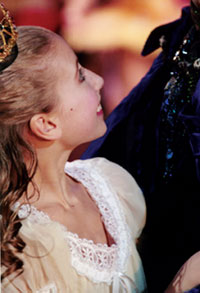 “Being in The Nutcracker requires a major commitment on behalf of the dancers,” explains Wellesley resident Pixley Schiciano, who teaches at the Center. As a ballet mistress who trains many of the young performers in their Nutcracker roles, Schiciano knows first hand. In addition to taking as many as five classes a week, beginning in October, students attend multiple rehearsals.
“Being in The Nutcracker requires a major commitment on behalf of the dancers,” explains Wellesley resident Pixley Schiciano, who teaches at the Center. As a ballet mistress who trains many of the young performers in their Nutcracker roles, Schiciano knows first hand. In addition to taking as many as five classes a week, beginning in October, students attend multiple rehearsals.
“There are lots of little details to incorporate into every scene and we can always use more practice to get it exactly right and to make our movements more beautiful,” Lauren says. “Because Clara dances in most of the Nutcracker scenes, there are many rehearsals to attend each week. Sometimes I attend two or three different rehearsals in the same day, in addition to my regular ballet class!” Homework happens whenever it can. It is a tradeoff many students in the ballet school are willing to make.
Young, talented dancers like Lauren are one of the reasons that The Nutcracker is the most popular ballet in the western world. “The kids really make the production special,” says Sarah Wroth, a member of the Boston Ballet Company’s Corps de Ballet who plays the children’s governess in the performance. “Not only do they bring with them a contagious energy and excitement to those first 20 minutes of each new performance, but they really represent the youthful magic that the show is all about.”
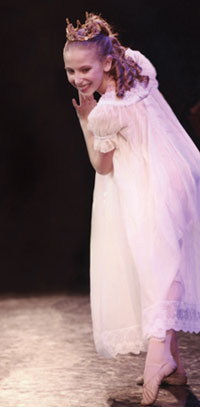 Several other features combine with the young dancers’ abilities to make The Nutcracker a favorite whether it is a once-in-a-lifetime experience or an annual holiday tradition. In the case of the Boston Ballet’s Nutcracker, imaginative sets provide a festive backdrop, including a 30-foot Christmas tree that grows in front of the audiences’ eyes and a hot air balloon that transports Clara and the Nutcracker prince to the Land of Sweets. There are glittering costumes, like that of the Sugar Plum Fairy, whose tutu contains over 300 pink and white beads that took designers in the Ballet’s costume shop 30 hours to attach by hand. Spectacular choreography envisioned by the Ballet’s Artistic Director, Mikko Nissinen, is set to Tchaikovsky’s iconic score—“Nutcracker March,” “Waltz of the Flowers,” and the ubiquitous “Dance of the Sugar Plum Fairy”—pieces that are synonymous with holiday cheer. And then there are the exquisite dancers of the Boston Ballet Company, indeed many of the world’s best, whose bodies tell the story of Christmas Eve at the Stahlbaum house through dances such as the Russian Trepak and the classic grande pas des deux.
Several other features combine with the young dancers’ abilities to make The Nutcracker a favorite whether it is a once-in-a-lifetime experience or an annual holiday tradition. In the case of the Boston Ballet’s Nutcracker, imaginative sets provide a festive backdrop, including a 30-foot Christmas tree that grows in front of the audiences’ eyes and a hot air balloon that transports Clara and the Nutcracker prince to the Land of Sweets. There are glittering costumes, like that of the Sugar Plum Fairy, whose tutu contains over 300 pink and white beads that took designers in the Ballet’s costume shop 30 hours to attach by hand. Spectacular choreography envisioned by the Ballet’s Artistic Director, Mikko Nissinen, is set to Tchaikovsky’s iconic score—“Nutcracker March,” “Waltz of the Flowers,” and the ubiquitous “Dance of the Sugar Plum Fairy”—pieces that are synonymous with holiday cheer. And then there are the exquisite dancers of the Boston Ballet Company, indeed many of the world’s best, whose bodies tell the story of Christmas Eve at the Stahlbaum house through dances such as the Russian Trepak and the classic grande pas des deux.
“I was a little nervous to be dancing with some of the company dancers because they are professional dancers who have accomplished so much,” says Lauren, “but once we got started my butterflies went away.”
When the final curtain falls on The Nutcracker’s stage, the Boston Ballet remains in full swing. As Lauren returns to her regular class schedule and Mother Ginger’s 40-pound hoop skirt is transported to the costume shop where it is stored above the entrance during the off season, ballet masters have already been preparing Company dancers for the rest of the spring season’s rich and varied performances.
“The Ballet is committed to maintaining a repertoire that combines timeless classics with the imaginative visions of today’s most innovative choreographers,” explains Mikko Nissinen, who provides the artistic vision for the Company.
True to its mission, the upcoming 2010 spring season includes the classic Coppélia, a light-hearted love story staged by choreographer George Balanchine that features twenty children from the Ballet School. Three signature ballets by Balanchine, a pioneer of ballet in the United States, are featured in Ultimate Balanchine. Black and White, a program by Jirí Kylián, one of today’s finest contemporary choreographers who challenges all ideas about what ballet can be, is back by popular demand. Last year one of the reviews in The Hub claimed that Black and White was, “A triumph; a must see; a dance that brings the audience to its feet, cheering.”
The Boston Ballet’s entrepreneurial spirit extends beyond its innovative performances. “The Boston Ballet School offers several ground-breaking education and community outreach programs,” says Linda Borden, a Wellesley resident and Boston Ballet Overseer.
Citydance provides scholarships to the Ballet School for third-grade students attending Boston public schools. Through weekly classes offered during the school day, every year 3,000 young boys and girls are introduced to a variety of dance forms, including classic ballet and African dance. As part of the program, students and their families are given the opportunity to attend one of the Company’s performances.
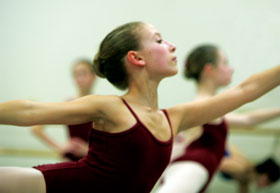 “Our hope is that we will inspire a life-long love of dance that will encourage young people to continue to dance, or at the very least, to more fully appreciate ballet,” Borden says.
“Our hope is that we will inspire a life-long love of dance that will encourage young people to continue to dance, or at the very least, to more fully appreciate ballet,” Borden says.
Some enthusiastic and talented third-graders are invited to continue with their ballet training at the end of the six-week program. Today there are fifty Citydance alumni enrolled in the Boston Ballet School with Citydance scholarship support. One alumnus, Isaac Akina, was recently promoted to Principal Dancer status, a testimony to the excellence of the School. Other alumni have gone on to dance with Cedar Lake Contemporary Ballet, the Sarasota Ballet, and the Eugene Ballet.
Joel Roman, a third-grade Citydance student, hopes he can continue with his Citydance classes. “I love the program and every Wednesday I can’t wait for the bus to come so I could get to Boston Ballet,” he says.
Mary Moran, a teacher at Clap Elementary School, echoes Roman’s enthusiasm. “The children loved it. This is a fantastic educational experience. It lifts the children from the common daily routine of their lives and takes them to a whole new creative experience. We don’t have music or dance in our school. The children loved the thoughtful, patient instruction that made it possible for everyone to enjoy.”
The School’s Adaptive Dance program brings the chance to dance to children with Down’s syndrome. A joint venture with the Department of Physical Therapy at Children’s Hospital, the goal of the program is for children to experience the pure joy of dance, music, and self-expression. As one parent observes, “It gives our kids an opportunity to relate to others like them, and with others involved in a unique arts experience.”
“Over 130 middle school girls have the chance to learn from local arts professionals in the Taking Steps program,” says Borden. The summer program offers dance training, performance opportunities, and instruction in various art forms including visual art, music, drama, and literature. Classes in finance, nutrition, injury prevention, and even the art of writing thank-you letters are interwoven in the curriculum, to provide participants with several essential life skills.
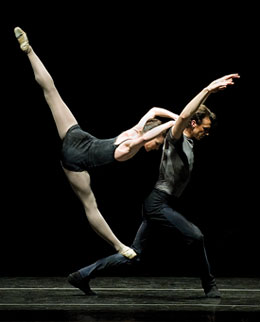 “Boston Ballet provides all programming, guest teachers, curriculum, and administrative support at no cost to students,” says Brynn Hale, Outreach Manager. Unlike other ballet companies, the Boston Ballet receives very little financial support from local government. “We are able to offer these programs because of strong ticket sales and the generous support of many corporate and individual sponsors.”
“Boston Ballet provides all programming, guest teachers, curriculum, and administrative support at no cost to students,” says Brynn Hale, Outreach Manager. Unlike other ballet companies, the Boston Ballet receives very little financial support from local government. “We are able to offer these programs because of strong ticket sales and the generous support of many corporate and individual sponsors.”
“Once people get to know the Boston Ballet, everyone wants to be a part of it,” says Schiciano. “We are at the cutting edge of dance internationally—the Company that every ballet company watches.”
There are myriad ways to be a part of the Boston Ballet. “Whether you are two or ninety-two, a beginner or pre-professional, you can receive top-notch training at the Dance Center,” explains Schiciano. Classes take place in its flagship dance space designed by architect Graham Gund in Boston’s South End, as well as three satellite studios in the region.
“As a patron of the Ballet, you can help sustain one of Boston’s cultural jewels,” offers Borden. “Ticket revenues and tuition cover just over half of the Ballet’s budget. Generous individuals make the difference.” Special performances, and the chance to observe practices, tour the costume shop, and meet members of the Company and students in the outreach programs, are some of the ways a supporter’s experiences of the Ballet are augmented.
Of course, there is nothing like watching the Boston Ballet’s performances. “Boston Ballet’s new home—the Opera House—is a thrilling place to experience dance,” says Nissinen.
“I love seeing the Nutcracker over and over again, either from the audience or from the stage, so I can watch different Boston Ballet company members in different roles,” Lauren Baltrus adds. “It’s a new performance every time.”
For more information about the Company, school, or outreach programs, visit www.bostonballet.org.

